
Knife Materials
-
From the sharp, classic edge of carbon steel to the rust-resistant brilliance of modern stainless,
discover how the right blade material can transform not just your kitchen, but the way you cook. -
Carbon Steel
-
Behind every legendary Japanese knife lies a story forged in steel.
Discover the secrets of Blue Steel and White Steel — and how their unique sharpness, durability, and feel in the hand can transform your cooking forever. -

White Steel #2
Where traditional sharpness begins.
Made from ultra-pure carbon steel, White Steel #2 offers razor-sharp edges that respond instantly to the whetstone. Its clarity and control make it ideal for chefs who value precision and the authentic feel of Japanese blades.

White Steel #1
Refined sharpness, elevated.
With higher carbon content than White Steel #2, White Steel #1 delivers a finer edge that lasts longer. It rewards skilled hands with unmatched precision, making it the choice for those who accept nothing less than excellence.

Blue Steel #2
Strength for the everyday professional.
Alloyed with tungsten and chromium, Blue Steel #2 balances keen sharpness with added durability and wear resistance. Trusted in busy kitchens, it delivers consistent performance service after service.
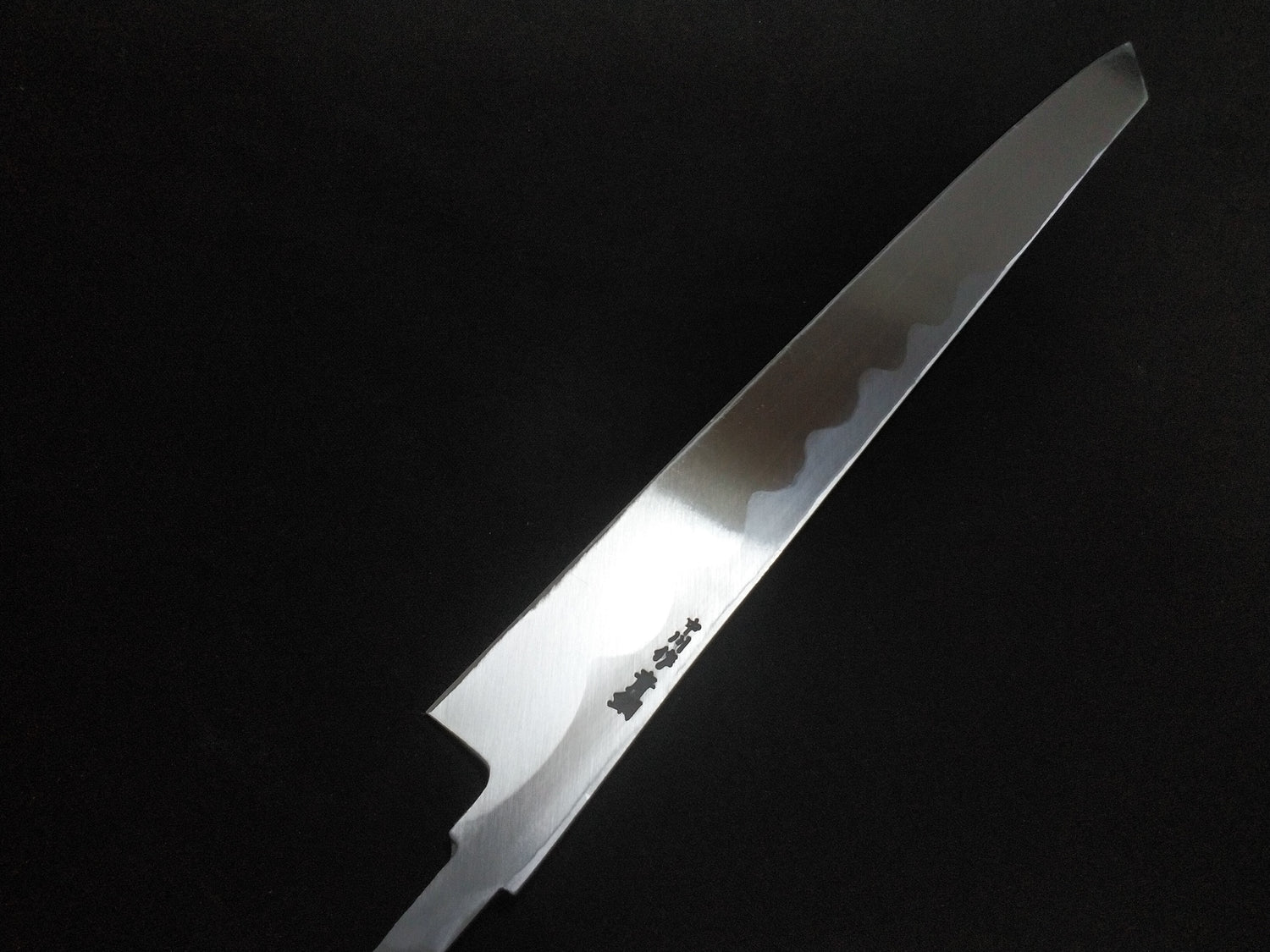
Blue Steel #1
Sharpness at its highest form.
Enriched with tungsten and chromium, Blue Steel #1 achieves superior hardness and edge longevity. Demanding yet rewarding, it is favored by master chefs who require flawless performance at the highest level.
Stainless Steel
-
From kitchen workhorse to modern masterpiece — discover the real story of stainless steel knives.
Learn why they resist rust, how decades of innovation have refined their edge, and why today’s stainless steel offers both convenience and exceptional cutting performance. -
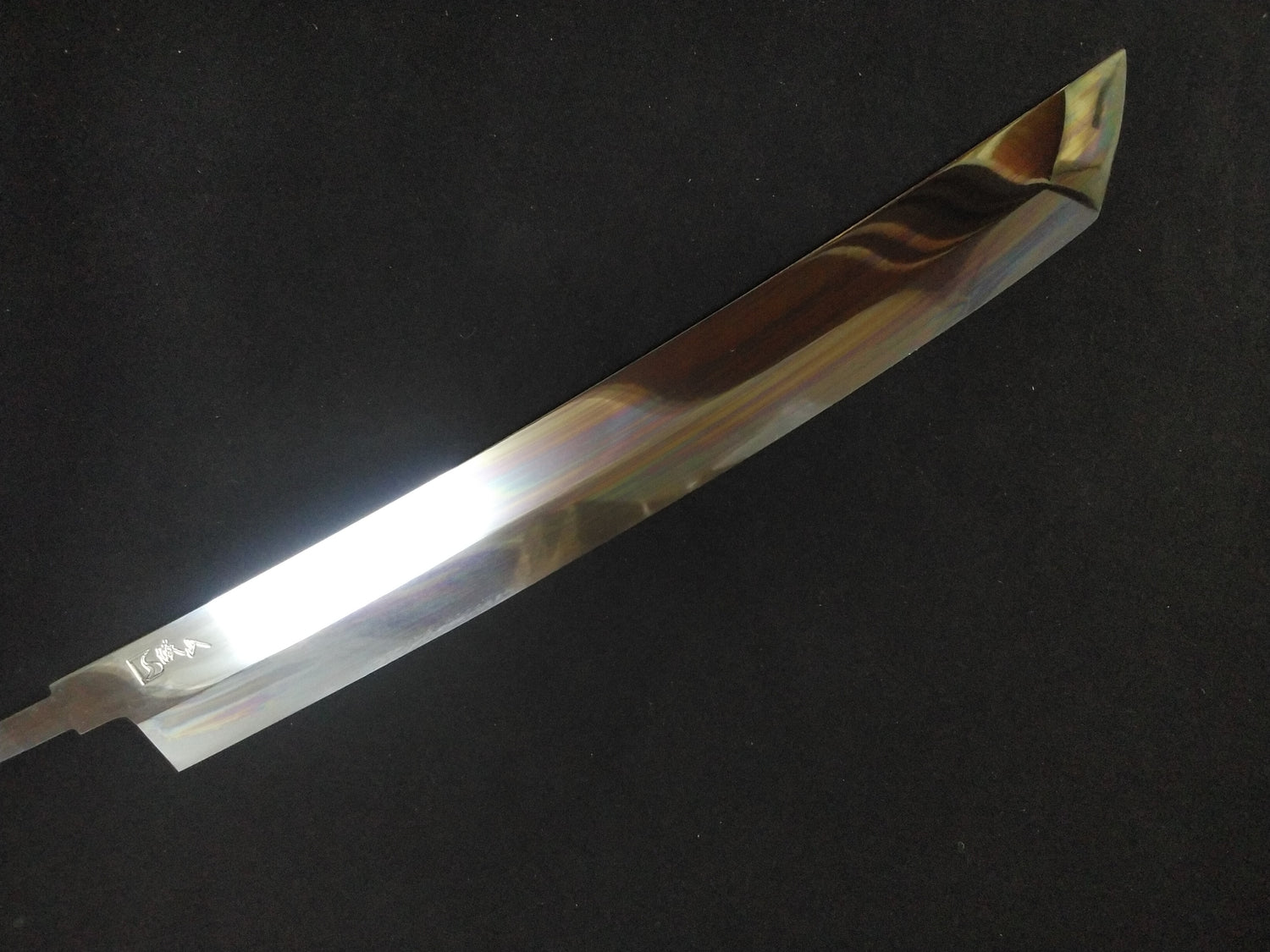
Super Steel (Honyaki)
A sword in the kitchen.
Forged from a single piece of steel and meticulously heat-treated, Honyaki represents the pinnacle of Japanese bladesmithing. Each blade embodies unrivaled sharpness, elegance, and the spirit of the artisan’s craft.

ZDP189
The cutting edge of innovation.
Created through advanced powder metallurgy by Proterial (formerly Hitachi Metals), ZDP189 achieves extreme hardness, exceptional edge retention, and rust resistance. A next-generation steel, it is trusted by leading chefs worldwide.

Ginsan
Stainless steel with a soul.
Developed by Proterial (formerly Hitachi Metals) and hand-forged by skilled artisans, Ginsan combines the sharpness of carbon steel with stainless ease. Its durability, rust resistance, and chip resilience make it a favorite for daily cooking.
Ⅰ. Why Japan Still Chooses Carbon Steel Knives in a Stainless Steel World?
-
Across the globe, stainless steel has become the default for kitchen knives. Easy to maintain, durable, and affordable, it dominates professional and home kitchens alike.
Yet in Japan, carbon steel remains the heart of traditional blades. Why does Japan stay loyal to this demanding material? The answer lies in more than performance—it is a reflection of philosophy, craftsmanship, and culture. -
1. Sharpness as a Culinary Philosophy
Carbon steel can be sharpened to an extraordinarily fine edge. This sharpness allows chefs to cut with surgical precision, preserving the structure, freshness, and flavor of ingredients—essential for delicate dishes like sashimi.
Just as important, carbon steel is easier to sharpen than stainless. For Japanese chefs, daily sharpening is not a chore but a ritual—an act of respect for their tools and their craft. -

2. Why the World Embraced Stainless Steel
Outside Japan, stainless steel became the standard for practical reasons. It resists rust, suits fast-paced kitchens, and adapts well to mass production. Western cooking often emphasizes durability over razor-thin precision, making stainless an obvious choice.
In Japan, however, where cuisine values finesse and refinement, carbon steel aligns more closely with culinary ideals. -
3. A Legacy of the Samurai Sword
Japanese kitchen knives are heirs to the forging traditions of samurai swords. Techniques developed for high-carbon blades were adapted into tools for the kitchen, carrying forward centuries of skill.
For blacksmiths, carbon steel is not just material—it is a medium through which tradition and artistry live on. -

4. A Knife That Grows With Its Owner
Carbon steel requires care—wiping, drying, regular sharpening. But in return, it develops a patina and character unique to each owner. Over time, the knife reflects its user’s habits and devotion, forging an emotional bond that stainless rarely inspires.
-
Conclusion: More Than Metal
Carbon steel is not the easy choice. It stains, it rusts, and it demands attention. Yet it offers sharpness, personalization, and cultural depth that stainless steel cannot match.
In Japan, a knife is never just a tool—it is an extension of the chef’s hand, a bridge to history, and a symbol of craftsmanship at its finest.
Beyond Sharpness: Why Japanese Knives Carry a Soul
-

Japanese knives are more than cutting tools—they embody centuries of craftsmanship, the spirit of the samurai, and a uniquely personal relationship between chef and blade.
Carbon steel delivers exceptional sharpness, develops a patina that reflects its owner’s journey, and invites a daily sharpening ritual that deepens both skill and appreciation.
What emerges is not just performance, but a soulful connection that grows stronger with every use. -
Ⅱ. Why Are Japanese Stainless Steel Knives So Rust-Resistant?
-
For chefs around the world, rust is one of the greatest enemies of a knife. Yet Japanese stainless steel knives, admired for their razor-sharp edges and refined beauty, are also celebrated for being surprisingly resistant to rust. Many assume such elegant tools require constant maintenance — but the truth is more fascinating.
The secret lies in chromium and a protective shield known as the passive film.
-

The Invisible Shield: Passive Film
When chromium (13% or more in most Japanese steels) reacts with oxygen, it forms an invisible oxide layer on the blade’s surface. This passive film blocks moisture and oxygen, preventing the red rust that quickly destroys ordinary steel.
What makes it extraordinary is its self-healing ability: if the blade is scratched, the film instantly reforms, giving the steel a second skin of protection.
-
Beyond Ordinary Stainless Steel
Western stainless steel typically contains 10.5% chromium — enough to resist rust but not enough for high-end performance. By contrast, Japanese steels such as Ginsan (Silver 3) are engineered with higher chromium content while retaining the sharpness and hardness of carbon steel. The result is blades that combine precision, durability, and rust resistance, trusted by top chefs worldwide.
-
Care Still Matters
Stainless steel is resilient, but not invincible. Dishwashers, salty environments, or acidic foods can compromise the passive film. That’s why Japanese chefs still hand wash, dry, and store their knives carefully — a simple ritual that protects both the steel and the spirit of the blade.
-

Science Meets Craftsmanship
Japanese stainless steel knives are more than rust-resistant tools. They are the fusion of metallurgy and tradition, crafted by artisans who refine the steel’s potential through generations of skill. Each blade is proof that science and craftsmanship together can create beauty that lasts a lifetime.
The Science Behind the Shield: Why Japanese Stainless Steel Defies Rust
-

Japanese stainless steel forms an invisible, self-repairing protective layer that reacts instantly with oxygen, giving the blade exceptional rust resistance without compromising sharpness.
With higher chromium content than standard Western steels, these blades maintain a superior balance of durability and cutting performance.
Still, this resilience is not limitless—proper hand-washing and drying are essential to keep the passive film strong and protect the knife for years to come. -
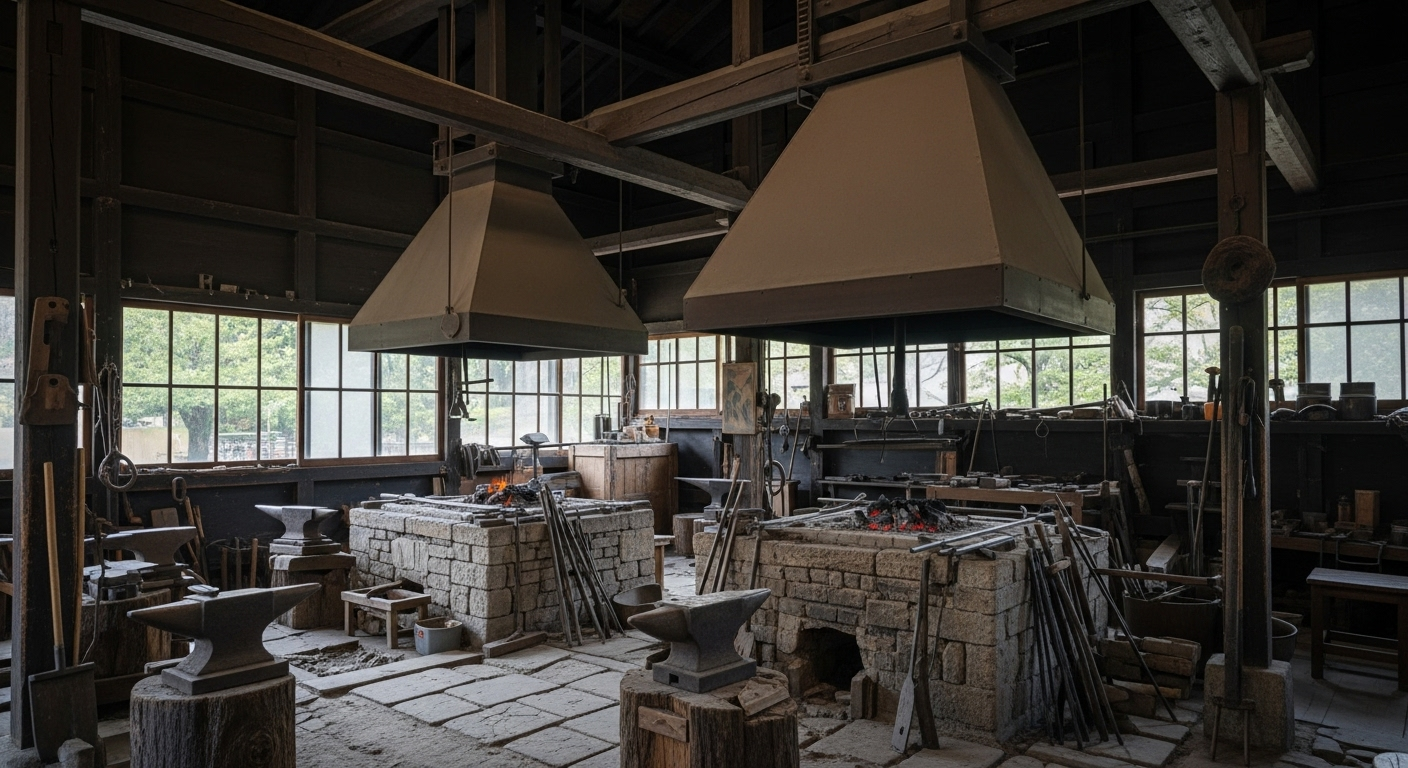
FAQ About Knife Materials

Q1. What does “knife steel” actually mean?
Knife steel refers to the type of metal used to craft the blade—the very foundation of a knife’s performance. In Japanese knives, the steel determines sharpness, ease of sharpening, rust resistance, and durability. Broadly, steels fall into two categories: carbon steel and stainless steel, each with distinct advantages that shape how the knife feels and performs in daily use.
Q2. What’s the difference between carbon steel and stainless steel?
Carbon steels such as Shirogami (White Steel) and Aogami (Blue Steel) are celebrated for their unmatched sharpness and the ease with which they can be resharpened. However, they are more vulnerable to rust and demand attentive care. These steels have long been favored by professional chefs and artisans who value ultimate cutting performance. Stainless steels, by contrast, offer excellent rust resistance and easier day-to-day maintenance. Thanks to modern metallurgy, premium stainless steels such as Ginsan now deliver sharpness once thought possible only in carbon steel, making them increasingly popular among professionals and home cooks alike.
Q3. Is “sharpness” the same as “ease of sharpening”?
Not quite. Sharpness describes how effortlessly a knife slices through ingredients, while ease of sharpening refers to how readily the blade regains its edge during maintenance. Carbon steels excel in both—they achieve razor-like sharpness and can be quickly restored on a whetstone. Stainless steels, while more convenient for everyday use, often retain their edge longer but may be more challenging to sharpen by hand, depending on the alloy.
Q4. Why are there so many types of Japanese knife steel?
Japanese knives are not merely tools but the result of centuries of culinary culture and craftsmanship. Over generations, blacksmiths have developed a wide range of steels, each tailored to specific cutting tasks, climates, and user preferences. This diversity reflects Japan’s dedication to refining performance to meet the exacting demands of professional cuisine and to honor the philosophy of constant improvement.
Q5. Does sharpening technique matter more than steel quality?
In many ways, yes. Even the finest steel cannot perform at its peak without proper sharpening. Conversely, a modest steel in the hands of someone skilled with a whetstone can achieve outstanding results. Steel provides the foundation, but true sharpness comes from technique and care—the dialogue between blade and user.
Q6. How do I choose the right steel for me?
The best choice depends on your cooking style and values. If you prefer low-maintenance convenience, stainless steel is often ideal. If you enjoy the satisfaction of sharpening your own blade and demand peak performance, carbon steel may be your match. At KIREAJI, we provide detailed information and expert guidance to help you make the right choice, so you can confidently find the steel that best complements your skills, habits, and passion for cooking—even when shopping online.
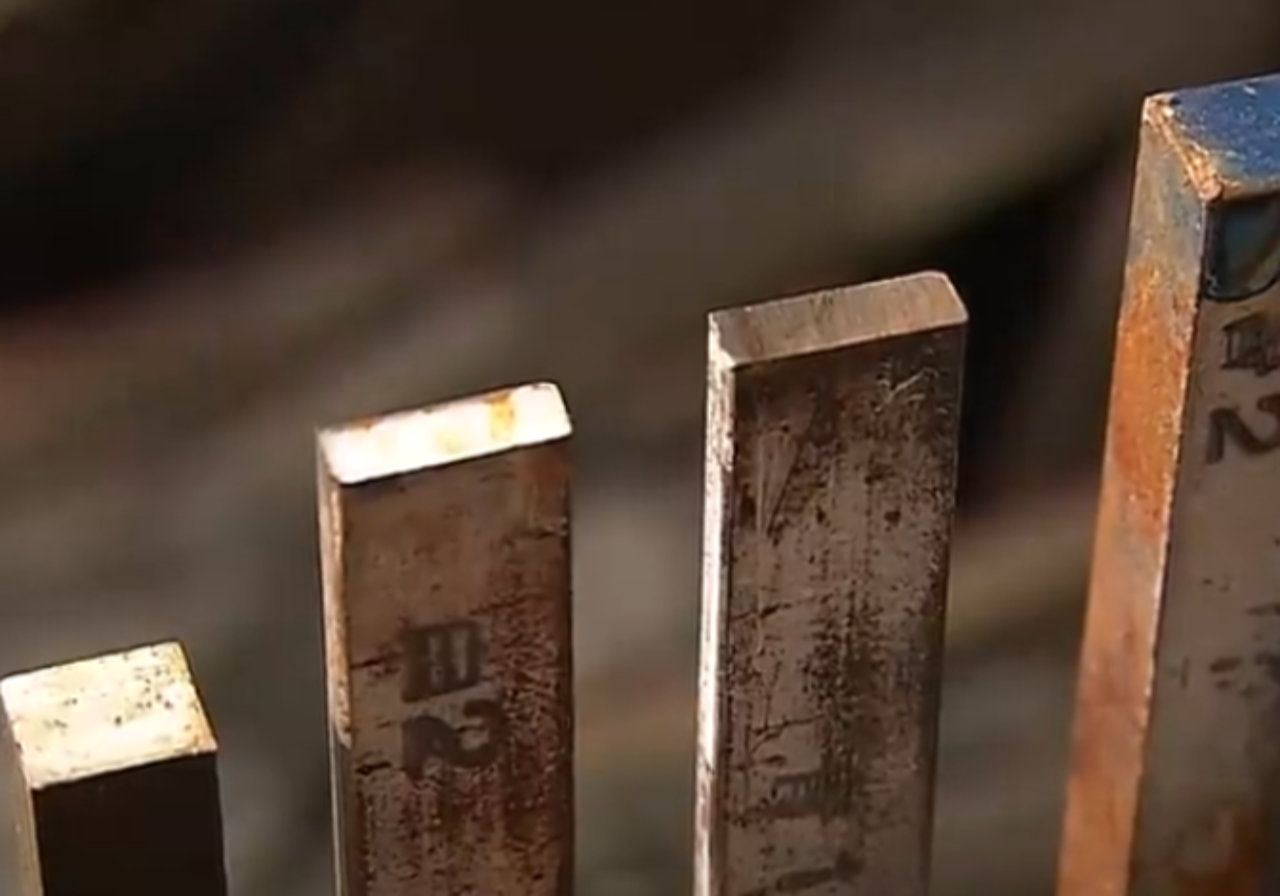
Japanese Knife Materials
The steel behind a Japanese knife defines its sharpness, durability, and care. From traditional carbon steels like White #2 and Blue #2 to modern innovations such as Ginsan and ZDP189, each material offers its own balance of performance and maintenance. This guide explores how these choices shape the knives we use today.
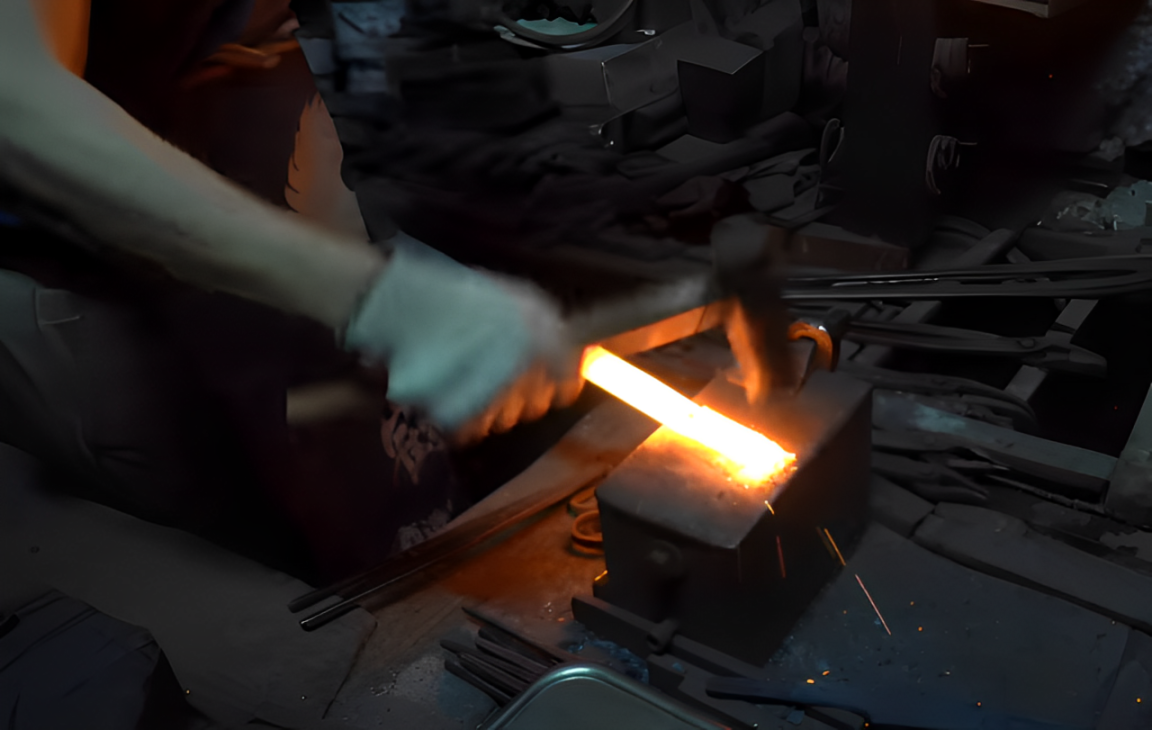
Sakai Knives: Each One Unique, Handcrafted by Master Artisans
Every Sakai knife is born from the hands of master artisans,Each stroke infused with soul and centuries of tradition.No two blades are ever the same –Your unique Sakai knife awaits, the only one of its kind in the world.
The Soul of Craftsmanship
-
The Lesson of Carbon Steel — A Bond Forged Through Care
Using a carbon steel knife teaches more than technique—it teaches respect and thoughtfulness toward your tools. Such blades demand daily care: without sharpening, wiping, and oiling, they may rust or lose their edge. Yet in this very need lies their beauty. The more attention you give, the more the knife rewards you with sharpness, resilience, and joy in use.
-
These small rituals are not chores but moments of gratitude, a way to connect with your tool and with the act of cooking itself. Through the touch of human hands, tools come alive, creating a cycle that unites people around the table.
-
This is the true charm of carbon steel knives. As artisans, we pour our hearts into every blade with the hope that those who hold them will not only use them, but also cherish and nurture them with love and care.
How Japanese Knives Are Made: The Sakai Tradition
VIDEO PROVIDED: JAPAN TRADITIONAL CRAFTS AOYAMA SQUARE (YOUTUBE)
-
Sakai Forged Blades — Six Centuries of Unrivaled Craftsmanship
Loved by chefs around the world and trusted by 98% of Japan’s top culinary professionals, Sakai knives are more than tools—they are the living legacy of over 600 years of master craftsmanship.
-
At KIREAJI, we work directly with the Shiroyama Knife Workshop in Sakai, Japan, ensuring every blade is hand-forged, finished to perfection, and shipped straight from the workshop to kitchens across the globe. No middlemen. No mass production. Only authentic, artisan-made knives, crafted to elevate your cooking for a lifetime.






